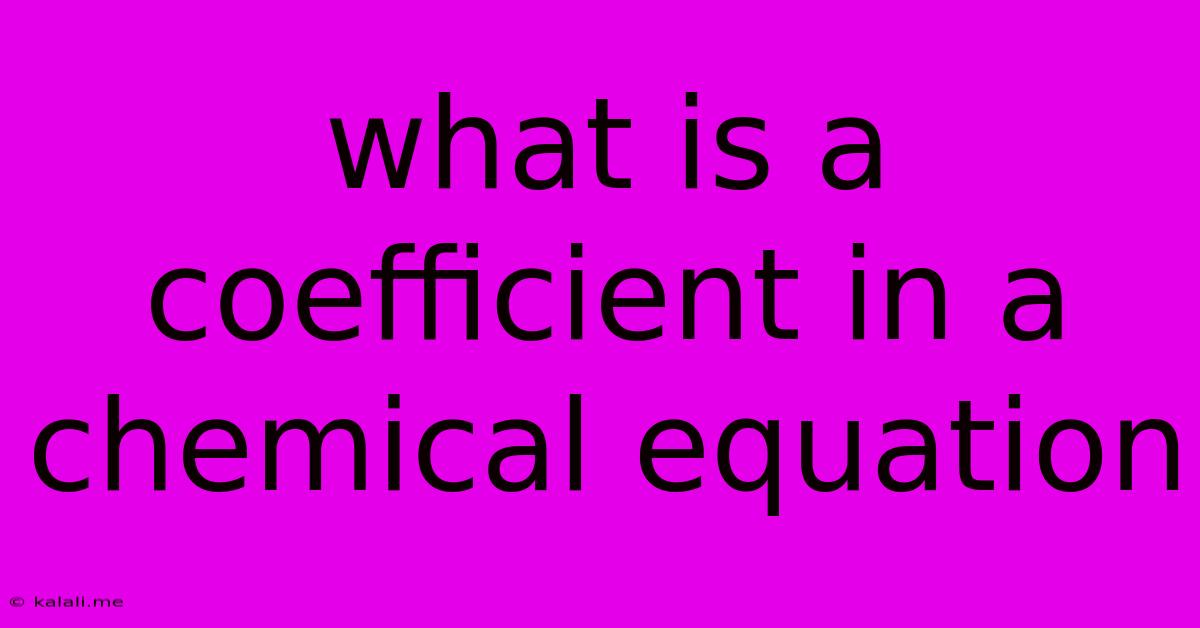What Is A Coefficient In A Chemical Equation
Kalali
May 09, 2025 · 3 min read

Table of Contents
What is a Coefficient in a Chemical Equation? A Comprehensive Guide
Meta Description: Learn the crucial role of coefficients in chemical equations – balancing equations, representing mole ratios, and understanding stoichiometry. This guide provides a clear explanation with examples.
Chemical equations are the shorthand language of chemistry, representing chemical reactions concisely. Within these equations, coefficients play a vital role in ensuring the equation's accuracy and providing critical information about the reaction's stoichiometry. This article will delve into the definition and significance of coefficients in chemical equations.
Understanding Coefficients: The Foundation of Balanced Equations
A coefficient in a chemical equation is a number placed before a chemical formula. It indicates the relative number of molecules or moles of that substance involved in the reaction. Unlike subscripts (which denote the number of atoms within a molecule), coefficients affect the entire molecule.
For example, in the balanced equation:
2H₂ + O₂ → 2H₂O
- The coefficient '2' before H₂ means two molecules of hydrogen gas (H₂) are reacting.
- The coefficient '1' (implied, not explicitly written) before O₂ indicates one molecule of oxygen gas (O₂) is reacting.
- The coefficient '2' before H₂O signifies that two molecules of water (H₂O) are produced.
The Importance of Balanced Chemical Equations
Coefficients are essential for balancing chemical equations. The law of conservation of mass dictates that matter cannot be created or destroyed in a chemical reaction; the total number of atoms of each element must be the same on both the reactant (left) and product (right) sides of the equation. Coefficients are adjusted to achieve this balance.
Coefficients and Mole Ratios: The Heart of Stoichiometry
Beyond balancing, coefficients reveal the mole ratios of reactants and products. This is the cornerstone of stoichiometry, the quantitative study of chemical reactions. The coefficients provide the precise proportions in which substances react and are formed.
In the equation above (2H₂ + O₂ → 2H₂O), the coefficients indicate:
- A 2:1 mole ratio of hydrogen to oxygen. Two moles of hydrogen react with one mole of oxygen.
- A 2:2 (or 1:1) mole ratio of hydrogen to water. Two moles of hydrogen produce two moles of water.
- A 1:2 mole ratio of oxygen to water. One mole of oxygen produces two moles of water.
Using Coefficients for Calculations
Coefficients are crucial for performing stoichiometric calculations. For example, if you know the number of moles of one reactant, you can use the mole ratios derived from the coefficients to calculate the amount of product formed or other reactants consumed.
Common Mistakes to Avoid
- Confusing coefficients and subscripts: Remember, coefficients affect the entire molecule, while subscripts describe the atoms within a molecule.
- Failing to balance equations properly: An unbalanced equation provides inaccurate information about the reaction's stoichiometry and is scientifically incorrect.
- Misinterpreting mole ratios: Always refer to the balanced equation to obtain the correct mole ratios.
Conclusion
Coefficients in chemical equations are not merely numbers; they are fundamental to understanding chemical reactions. They ensure the equation is balanced, reveal crucial mole ratios, and form the foundation for accurate stoichiometric calculations. Mastering the concept of coefficients is essential for anyone studying or working with chemistry.
Latest Posts
Latest Posts
-
19 8 As A Mixed Number
May 10, 2025
-
What Is 160 Minutes In Hours
May 10, 2025
-
How Many Cups Of Water Are In 16 9 Oz
May 10, 2025
-
What Is 42 Fahrenheit To Celsius
May 10, 2025
-
Why Does Secondary Succession Occur Faster Than Primary Succession
May 10, 2025
Related Post
Thank you for visiting our website which covers about What Is A Coefficient In A Chemical Equation . We hope the information provided has been useful to you. Feel free to contact us if you have any questions or need further assistance. See you next time and don't miss to bookmark.